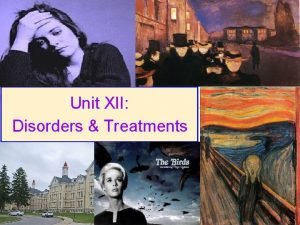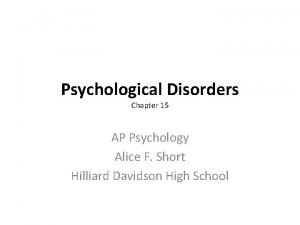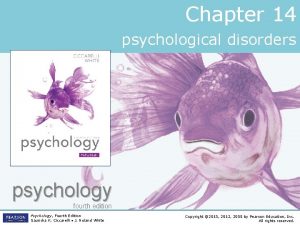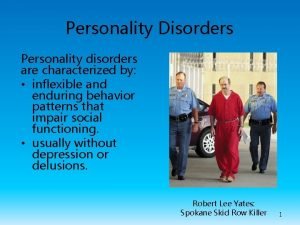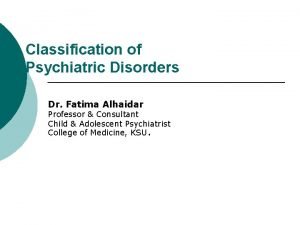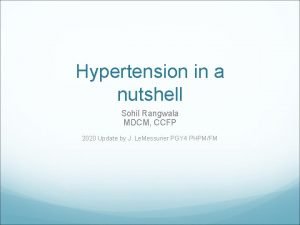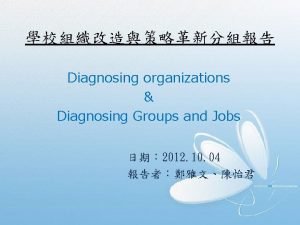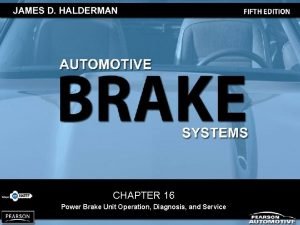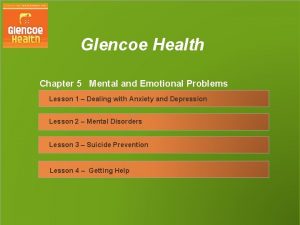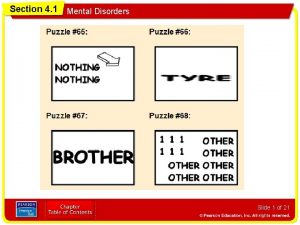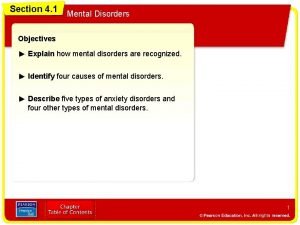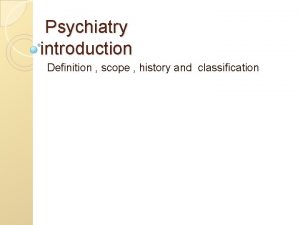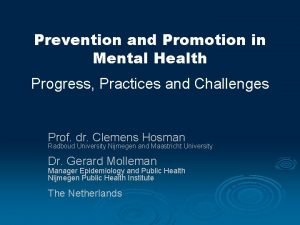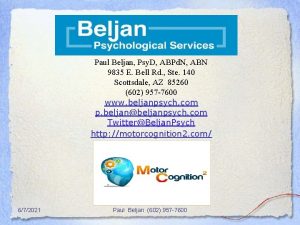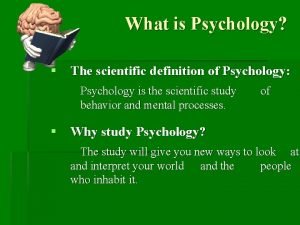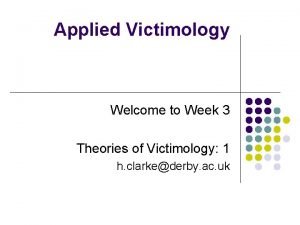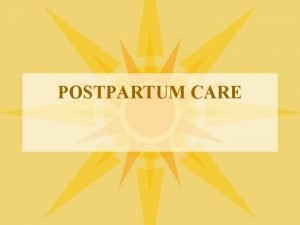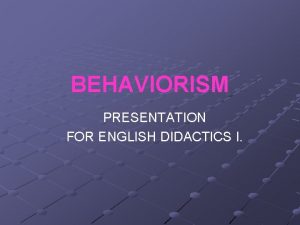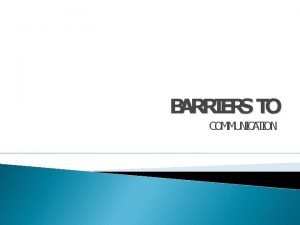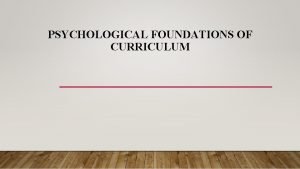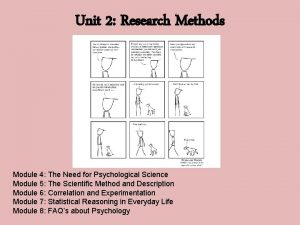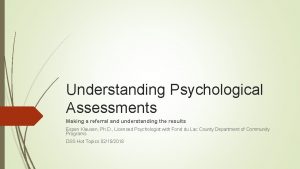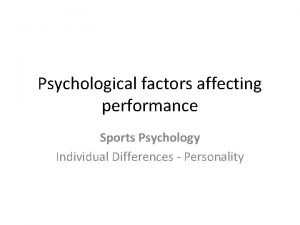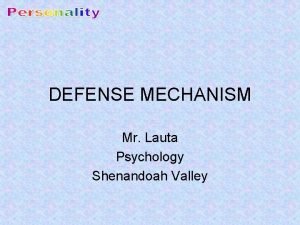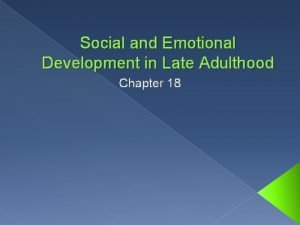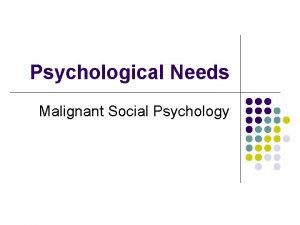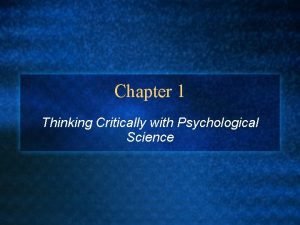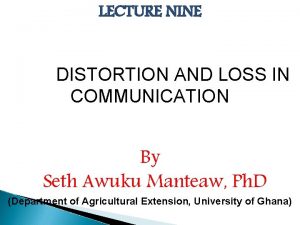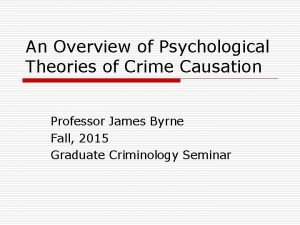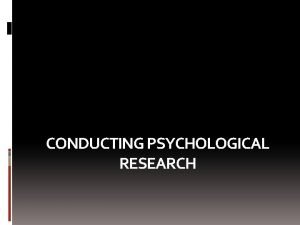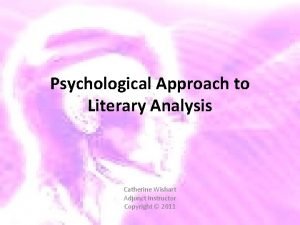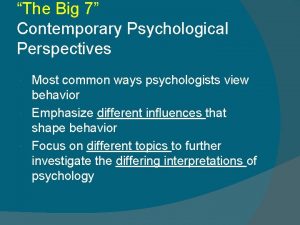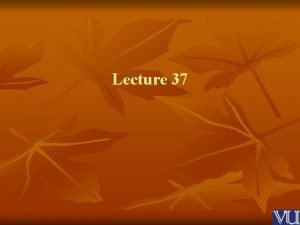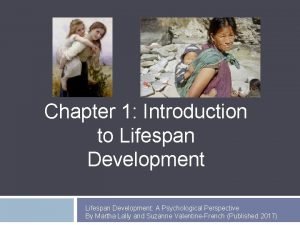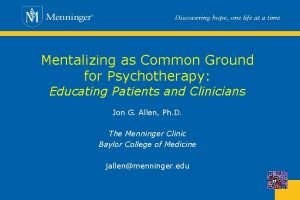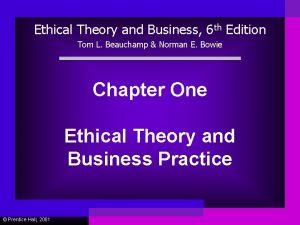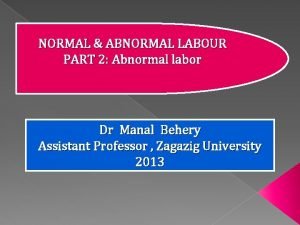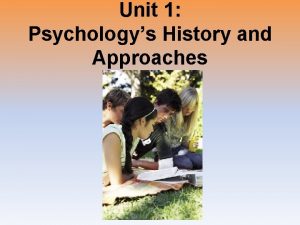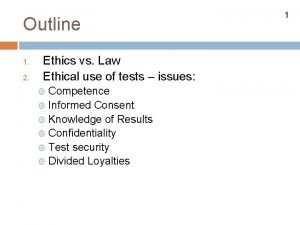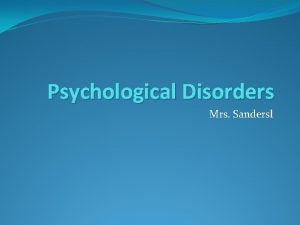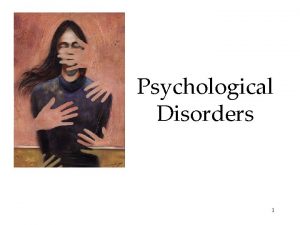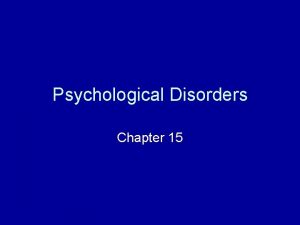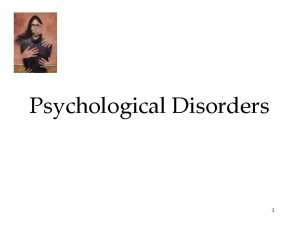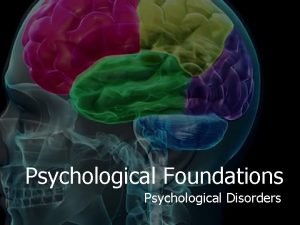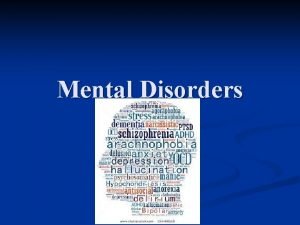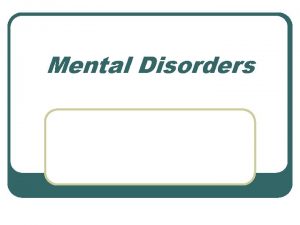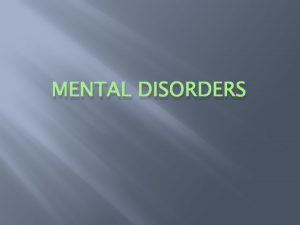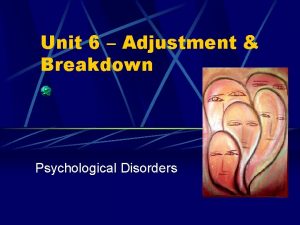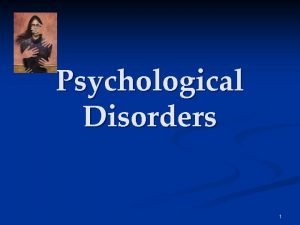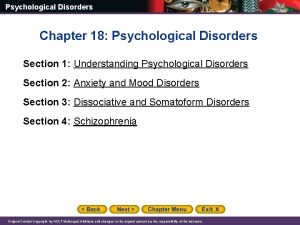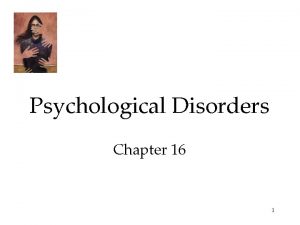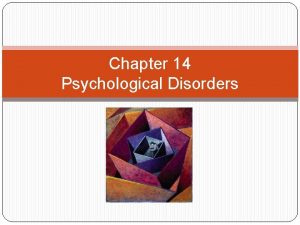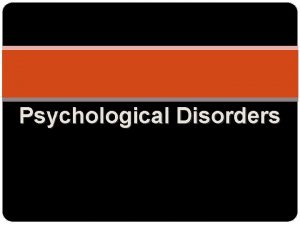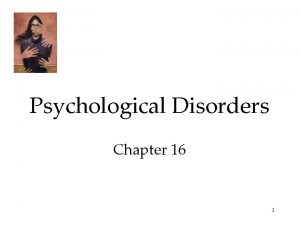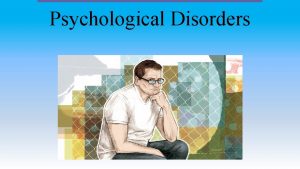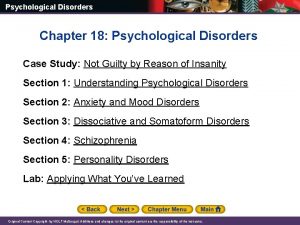15 PSYCHOLOGICAL DISORDERS 15 1 Diagnosing Mental Disorders






























































- Slides: 62

15 PSYCHOLOGICAL DISORDERS 15. 1 Diagnosing Mental Disorders 15. 5 Personality Disorders 15. 2 Anxiety Disorders 15. 6 Drug Abuse and Addiction 15. 3 Trauma and Obsessive– Compulsive Disorders 15. 7 Dissociative Identity Disorder 15. 4 Depressive and Bipolar Disorders 15. 8 Schizophrenia PSYCHOLOGY, Twelfth Edition | Carole Wade • Carol Tavris Copyright © 2017, 2014, 2011 Pearson Education Inc. All rights reserved.

15. 1 Diagnosing Mental Disorders Copyright © 2017, 2014, 2011 Pearson Education Inc. All rights reserved.

15. 1 Module Learning Objectives 15. 1. A Consider why it is difficult to obtain a universally agreed-upon definition of “mental disorder. ” 15. 1. B Describe four dangers associated with using the DSM for diagnosis of mental disorders, and give an example of each. 15. 1. C Explain theoretical basis of projective tests, and identify the problems associated with these techniques. Copyright © 2017, 2014, 2011 Pearson Education Inc. All rights reserved.

Dilemmas of Definition Mental disorder: Any behavior or emotional state that: • Causes an individual great suffering • Is self-destructive • Seriously impairs the person’s ability to work or get along with others • Makes a person unable to control the impulse to endanger others Copyright © 2017, 2014, 2011 Pearson Education Inc. All rights reserved.

Dilemmas of Diagnosis Diagnostic and Statistical Manual of Mental Disorders (DSM): APA’s standard reference manual used to diagnose mental disorders Copyright © 2017, 2014, 2011 Pearson Education Inc. All rights reserved.

Classifying Disorders: The DSM Critics: Inherent problems in DSM: • The danger of overdiagnosis • The power of diagnostic labels • Confusion of serious mental disorders with normal problems • The illusion of objectivity Supporters: It is important to help clinicians distinguish among disorders that share certain symptoms, such as anxiety, irritability, or delusions, so they can be diagnosed reliably and treated properly. Copyright © 2017, 2014, 2011 Pearson Education Inc. All rights reserved.

CULTURE AND MENTAL ILLNESS Are Mental Problems the Same Everywhere? Universal disorders Examples: Schizophrenic delusions, depression, panic attacks The DSM-5 discusses three culture-related concepts: Cultural syndrome • Ataque de nervios Culture idiom of distress • Kufungisisa Cultural explanation of symptoms • Maladi moun Copyright © 2017, 2014, 2011 Pearson Education Inc. All rights reserved.

Dilemmas of Determination: Projective Tests Projective tests: Used to infer a person’s motives, conflicts, and unconscious dynamics on the basis of the person’s interpretation of ambiguous stimuli • Rorschach Inkblot Test • Anatomically detailed dolls Low reliability and validity Copyright © 2017, 2014, 2011 Pearson Education Inc. All rights reserved.

Dilemmas of Measurement: Objective Tests Objective tests (inventories): Standardized objective questionnaires requiring written responses; typically include scales on which people are asked to rate themselves • Beck Depression Inventory • Minnesota Multiphasic Personality Inventory (MMPI) Generally more reliable and valid than projective tests Copyright © 2017, 2014, 2011 Pearson Education Inc. All rights reserved.

15. 2 Anxiety Disorders Copyright © 2017, 2014, 2011 Pearson Education Inc. All rights reserved.

15. 2 Module Learning Objectives 15. 2. A Differentiate the major symptoms of generalized anxiety disorder and panic disorder. 15. 2. B Describe the characteristics of a phobia, and explain why agoraphobia can be so disabling. Copyright © 2017, 2014, 2011 Pearson Education Inc. All rights reserved.

Anxiety and Panic Generalized anxiety disorder A continuous state of anxiety marked by: • Feelings of worry and dread • Apprehension • Difficulties in concentration • Signs of motor tension Possible causes: • Genetic predisposition • Experience Copyright © 2017, 2014, 2011 Pearson Education Inc. All rights reserved.

Panic Disorder An anxiety disorder in which a person experiences recurring panic attacks, periods of intense fear, and feelings of impending doom or death, accompanied by physiological symptoms such as rapid heart rate and dizziness Copyright © 2017, 2014, 2011 Pearson Education Inc. All rights reserved.

Panic Disorder Copyright © 2017, 2014, 2011 Pearson Education Inc. All rights reserved.

Fears and Phobias Phobia An exaggerated, unrealistic fear of a specific situation, activity, or object Social phobia Individuals become extremely anxious in situations in which they will be observed by others Agoraphobia A set of phobias, often set off by a panic attack, involving the basic fear of being away from a safe place or person; a “fear of fear” Copyright © 2017, 2014, 2011 Pearson Education Inc. All rights reserved.

15. 3 Trauma and Obsessive– Compulsive Disorders Copyright © 2017, 2014, 2011 Pearson Education Inc. All rights reserved.

15. 3 Module Learning Objectives 15. 3. A Define posttraumatic stress disorder, and discuss its symptoms and origins. 15. 3. B Distinguish between obsessions and compulsions, and discuss the defining elements of obsessive–compulsive disorder. Copyright © 2017, 2014, 2011 Pearson Education Inc. All rights reserved.

Posttraumatic Stress Disorder • A disorder in which a person who has experienced a traumatic or life-threatening event has symptoms such as nightmares, flashbacks, insomnia, reliving of the trauma, and increased physiological arousal • Diagnosed if symptoms persist for one month or longer Copyright © 2017, 2014, 2011 Pearson Education Inc. All rights reserved.

Obsessions and Compulsions Obsessive–compulsive disorder (OCD) An anxiety disorder in which a person feels trapped in repetitive, persistent thoughts (obsessions) and repetitive, ritualized behaviors (compulsions) designed to reduce anxiety Person understands that the ritual behavior is senseless but guilt mounts if the behavior is not performed Copyright © 2017, 2014, 2011 Pearson Education Inc. All rights reserved.

15. 4 Depressive and Bipolar Disorders Copyright © 2017, 2014, 2011 Pearson Education Inc. All rights reserved.

15. 4 Module Learning Objectives 15. 4. A Describe how major depression differs from normal feelings of sadness or loneliness. 15. 4. B Explain the main features of bipolar disorder. 15. 4. C Discuss the four major factors that contribute to the onset of depression. Copyright © 2017, 2014, 2011 Pearson Education Inc. All rights reserved.

Depression Major depression A disorder involving disturbances in: • Emotion (excessive sadness) • Behavior (loss of interest in one’s usual activities) • Cognition (thoughts of hopelessness) • Body function (fatigue and loss of appetite) Copyright © 2017, 2014, 2011 Pearson Education Inc. All rights reserved.

Bipolar Disorder Bipolar disorder: A mood disorder in which episodes of both depression and mania (excessive euphoria) occur Copyright © 2017, 2014, 2011 Pearson Education Inc. All rights reserved.

Origins of Depression Vulnerability-Stress Model: Approaches that emphasize how individual vulnerabilities interact with external stresses or circumstances to produce specific mental disorders, such as depression Copyright © 2017, 2014, 2011 Pearson Education Inc. All rights reserved.

Origins of Depression Genetic predispositions Violence, childhood physical abuse, and parental neglect Losses of important relationships Cognitive habits Copyright © 2017, 2014, 2011 Pearson Education Inc. All rights reserved.

Genetic Predispositions • Major depression is moderately heritable; genes must be involved for some individuals. • Search for specific genes has been unsuccessful. • New Zealand study on serotonin receptor gene 5 -HTT – Initial conclusions showing interactions between genes and experience were premature. – Nonetheless, research into gene– environment interactions continues. Copyright © 2017, 2014, 2011 Pearson Education Inc. All rights reserved.

Violence and Parental Neglect Repeated experiences with violence • One of the most powerful factors associated with clinical depression Childhood maltreatment • Effects of maltreatment in childhood on later depression are independent of all other childhood and adult risk factors Domestic violence • Contributes to depression in women Copyright © 2017, 2014, 2011 Pearson Education Inc. All rights reserved.

Losses of Important Relationships When an infant is separated from a primary attachment figure: • Despair • Passivity • Harm to immune system Many depressed people have a history of: • • Separations Losses Rejections Impaired, insecure attachments Copyright © 2017, 2014, 2011 Pearson Education Inc. All rights reserved.

Cognitive Habits Depression involves specific, negative ways of thinking about one’s situation Depressed people believe their situation is: • Permanent • Uncontrollable Rumination: Brooding about negative aspects of one’s life • More common in women Copyright © 2017, 2014, 2011 Pearson Education Inc. All rights reserved.

15. 5 Personality Disorders Copyright © 2017, 2014, 2011 Pearson Education Inc. All rights reserved.

15. 5 Module Learning Objectives 15. 5. A Explain the main features of borderline personality disorder. 15. 5. B Distinguish between the terms psychopathy and antisocial personality disorder, and note the common elements of each. 15. 5. C List and explain the major factors that contribute to the central features of psychopathy. Copyright © 2017, 2014, 2011 Pearson Education Inc. All rights reserved.

Personality Disorders Personality disorders Impairments in personality that cause great distress or an inability to get along with others • Borderline personality disorder: Characterized by extreme negative emotionality and inability to regulate emotions Copyright © 2017, 2014, 2011 Pearson Education Inc. All rights reserved.

Antisocial Personality Disorder Characterized by a lifelong pattern of irresponsible, antisocial behavior such as law-breaking, violence, and other impulsive, restless acts Copyright © 2017, 2014, 2011 Pearson Education Inc. All rights reserved.

Psychopathy: Myths and Evidence Psychopathy A personality disorder characterized by: • Fearlessness • Lack of empathy, guilt, and remorse • The use of deceit • Coldheartedness Copyright © 2017, 2014, 2011 Pearson Education Inc. All rights reserved.

Psychopathy: Myths and Evidence Psychopathy: • It is not the same as being violent and sadistic • It is not the same as being psychotic • “Born, not made” appears to be wrong • The belief that psychopaths cannot change is wrong Copyright © 2017, 2014, 2011 Pearson Education Inc. All rights reserved.

Figure 15. 2: Emotions and Psychopathy Copyright © 2017, 2014, 2011 Pearson Education Inc. All rights reserved.

15. 6 Drug Abuse and Addiction Copyright © 2017, 2014, 2011 Pearson Education Inc. All rights reserved.

15. 6 Module Learning Objectives 15. 6. A Discuss how the biological model of addiction would explain drug abuse and alcoholism. 15. 6. B Discuss how the learning model of addiction would explain drug abuse and alcoholism. 15. 6. C Explain the different predictions that the biological model and learning model would make regarding the benefits of total abstinence from versus moderate intake of alcohol. Copyright © 2017, 2014, 2011 Pearson Education Inc. All rights reserved.

Biology and Addiction Biological model Addiction is due primarily to a person’s neurology and genetic predisposition: • Begins in early adolescence • Is linked to impulsivity, antisocial behavior, criminality Genes affect sensitivity to alcohol. Heavy drug abuse changes the brain and makes addiction more likely. Copyright © 2017, 2014, 2011 Pearson Education Inc. All rights reserved.

Figure 15. 3: The Addicted Brain Copyright © 2017, 2014, 2011 Pearson Education Inc. All rights reserved.

Learning, Culture, and Addiction • Addiction patterns vary according to cultural practices. • Policies of total abstinence tend to increase addiction rates rather than reduce them. • Not all addicts have withdrawal symptoms when they stop taking a drug. • Addiction does not depend on properties of the drug alone but also on the reasons for taking it. Copyright © 2017, 2014, 2011 Pearson Education Inc. All rights reserved.

Debating the Causes of Addiction Copyright © 2017, 2014, 2011 Pearson Education Inc. All rights reserved.

15. 7 Dissociative Identity Disorder Copyright © 2017, 2014, 2011 Pearson Education Inc. All rights reserved.

15. 7 Module Learning Objectives 15. 7. A Discuss the factors that make dissociative identity disorder a controversial diagnosis. 15. 7. B Evaluate the likely explanations for dissociative personality disorder. Copyright © 2017, 2014, 2011 Pearson Education Inc. All rights reserved.

Dissociative Identity Disorder A controversial disorder marked by the appearance within one person of two or more distinct personalities, each with its own name and traits • Formerly known as Multiple Personality Disorder (MPD) Copyright © 2017, 2014, 2011 Pearson Education Inc. All rights reserved.

Can You See the Real Me? • Some psychiatrists and clinical psychologists take dissociative identity disorder very seriously • Starts in childhood as a means of coping with sexual abuse, traumatic experiences • Mental “splitting” (dissociation) caused by trauma • “Dissociative amnesia” lacks historical and empirical support Copyright © 2017, 2014, 2011 Pearson Education Inc. All rights reserved.

Putting the Pieces Together • Extreme form of the ability to present different aspects of our personalities to others • Created through pressure and suggestion by clinicians working with vulnerable patients • Shift from handfuls of diagnoses to tens of thousands in a decade – Media coverage – Lucrative business Copyright © 2017, 2014, 2011 Pearson Education Inc. All rights reserved.

15. 8 Schizophrenia Copyright © 2017, 2014, 2011 Pearson Education Inc. All rights reserved.

15. 8 Module Learning Objectives 15. 8. A Describe the five major symptoms of schizophrenia, and give an example of each. 15. 8. B Describe three main contributing factors to the origin of schizophrenia. Copyright © 2017, 2014, 2011 Pearson Education Inc. All rights reserved.

Symptoms of Schizophrenia Psychotic disorder marked by delusions, hallucinations, disorganized and incoherent speech, inappropriate behavior, and cognitive impairments. • Example of a psychosis Copyright © 2017, 2014, 2011 Pearson Education Inc. All rights reserved.

Symptoms of Schizophrenia 1 Bizarre delusions 2 Hallucinations 3 Disorganized, incoherent speech 4 Grossly disorganized or catatonic behavior 5 Negative symptoms Copyright © 2017, 2014, 2011 Pearson Education Inc. All rights reserved.

Origins of Schizophrenia Genetic predispositions Prenatal problems or birth complications Biological events during adolescence Copyright © 2017, 2014, 2011 Pearson Education Inc. All rights reserved.

Figure 15. 4: Schizophrenia and the Brain Copyright © 2017, 2014, 2011 Pearson Education Inc. All rights reserved.

Figure 15. 5: Genetic Vulnerability to Schizophrenia Copyright © 2017, 2014, 2011 Pearson Education Inc. All rights reserved.

Prenatal Problems or Birth Complications Damage to the fetal brain increases likelihood of schizophrenia later in life. • May occur as a function of maternal malnutrition or illness • May also occur if brain injury or oxygen deprivation occurs at birth • There are other nongenetic prenatal factors Copyright © 2017, 2014, 2011 Pearson Education Inc. All rights reserved.

Biological Events During Adolescence In adolescence, the brain undergoes a natural pruningaway of synapses. In individuals with schizophrenia, a greater number of synapses are pruned away. • May explain why first episode occurs in adolescence or early adulthood Copyright © 2017, 2014, 2011 Pearson Education Inc. All rights reserved.

Figure 15. 6: The Adolescent Brain and Schizophrenia Copyright © 2017, 2014, 2011 Pearson Education Inc. All rights reserved.

Taking Psychology with You Mental Disorder and Personal Responsibility • People who commit crimes or behave reprehensibly must face the consequences of their behavior. • At the same time, people with psychological problems should have the compassionate support of society in their search for help. Copyright © 2017, 2014, 2011 Pearson Education Inc. All rights reserved.

End of Chapter Copyright © 2017, 2014, 2011 Pearson Education Inc. All rights reserved.

Acknowledgments Copyright © 2017, 2014, 2011 Pearson Education Inc. All rights reserved.

Slide Credit Slide 4 Ioannis Pantzi. Shutterstock Slide 5 Adisa. Shutterstock Slide 7 Thorsten Schmitt. Shutterstock Slide 8 Kovalchuk Oleksandr. Shutterstock Slide 9 Mega Pixel. Shutterstock Slide 12 Kamira. Shutterstock Slide 13 Velychko. Shutterstock Slide 15 Nachiketa Bajaj. Shutterstock Slide 18 Oleg Zabielin. Shutterstock Slide 19 Abas Kamal bin Sulaiman. Shutterstock Slide 22 Piotr Marcinski. Shutterstock Slide 23 Dmitry Lobanov. Shutterstock Slide 23 Piotr Marcinski. Shutterstock Slide 26 Alex Mit. Shutterstock Slide 27 Artem Furman. Shutterstock Slide 28 hikrcn. Shutterstock Slide 29 Oleg Golovnev. Shutterstock Slide 32 luxorphoto. Shutterstock Slide 33 Blazej Lyjak. Shutterstock Slide 39 David Orcea. Shutterstock Slide 41 David Orcea. Shutterstock Slide 45 Gabriela Trojanowska. Shutterstock Slide 46 A. R. Monko. Shutterstock Copyright © 2017, 2014, 2011 Pearson Education Inc. All rights reserved.

Slide Credit Slide 50 Steven Frame. Shutterstock Slide 55 123 rf. com Slide 56 Cheryl Casey. Shutterstock Slide 58 quetton. Shutterstock Copyright © 2017, 2014, 2011 Pearson Education Inc. All rights reserved.
 Bipolar disorder meaning
Bipolar disorder meaning Chapter 18 psychological disorders
Chapter 18 psychological disorders Ap psychology chapter 15
Ap psychology chapter 15 Medical model psychology
Medical model psychology Chapter 14 psychological disorders
Chapter 14 psychological disorders Inflexible personality
Inflexible personality Chapter 14 psychological disorders
Chapter 14 psychological disorders Psychological disorders
Psychological disorders Eular criteria for ra
Eular criteria for ra Standardized office bp measurement
Standardized office bp measurement Diagnosing your cultural intelligence
Diagnosing your cultural intelligence Diagnosing hypertension
Diagnosing hypertension Comprehensive model for diagnosing organizational systems
Comprehensive model for diagnosing organizational systems Diagnosing error in object detectors
Diagnosing error in object detectors The first step in diagnosing a hydro-boost problem is
The first step in diagnosing a hydro-boost problem is Chapter 5 glencoe health answers
Chapter 5 glencoe health answers Section 4-1 mental disorders answers
Section 4-1 mental disorders answers Chapter 5 mental and emotional problems lesson 2 answer key
Chapter 5 mental and emotional problems lesson 2 answer key Section 4-1 mental disorders answers
Section 4-1 mental disorders answers Classification of mental disorders
Classification of mental disorders Chapter 21 mental health diseases and disorders
Chapter 21 mental health diseases and disorders Mental health disorders
Mental health disorders Mental health and mental illness chapter 20
Mental health and mental illness chapter 20 Mental illness mental health jeopardy
Mental illness mental health jeopardy Paul beljan
Paul beljan What is psychology
What is psychology Mendelsohn's theory of victimization
Mendelsohn's theory of victimization Rubin's phases of postpartum change
Rubin's phases of postpartum change Behaviorism psychology
Behaviorism psychology Strategies to overcome communication barriers
Strategies to overcome communication barriers Human morality
Human morality Psychological rate limiters
Psychological rate limiters Psychological foundations of curriculum
Psychological foundations of curriculum Egoism ethics
Egoism ethics Module 4 the need for psychological science
Module 4 the need for psychological science Iq test score range
Iq test score range Hollander 1967 model of personality
Hollander 1967 model of personality Psychological factors influencing learning
Psychological factors influencing learning Trafford psychological therapies
Trafford psychological therapies Types of defense mechanisms in psychology
Types of defense mechanisms in psychology Robert peck's stages of psychological development
Robert peck's stages of psychological development Bbhi 2 psychological test
Bbhi 2 psychological test Kitwood flower of needs
Kitwood flower of needs Thinking critically with psychological science answer key
Thinking critically with psychological science answer key Psychological noise.
Psychological noise. Psychological theories crime causation
Psychological theories crime causation Steps of psychological research
Steps of psychological research What is psychological approach in literature
What is psychological approach in literature 7 psychological perspectives
7 psychological perspectives Types of psychological research
Types of psychological research Five principles of psychological functioning
Five principles of psychological functioning Psychological suspense definition
Psychological suspense definition Discontinuous development psychology
Discontinuous development psychology Psychological hardiness
Psychological hardiness Psychological trauma
Psychological trauma Psychological egoism examples
Psychological egoism examples Psychological noise in communication
Psychological noise in communication Hydroceplus
Hydroceplus Psychological perspectives
Psychological perspectives Pearlin
Pearlin Psychological egoism examples
Psychological egoism examples Divided loyalties in psychological testing
Divided loyalties in psychological testing Psychological factors of personality
Psychological factors of personality
